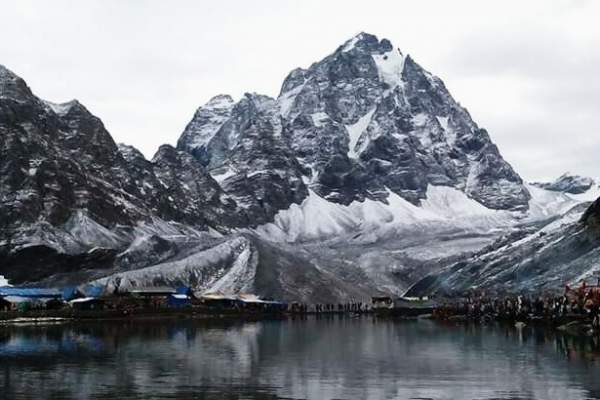Even though the Manimahesh Lake is of small size with shallow depth, its location, directly below Manimahesh Kailas peak and several other peaks and dangling glaciers, is an “inspiration even to the least devout pilgrim.”
Trekking in the last reach is through the glacier fields of the lake. However, on the way, the walk is through the valley of flowers and wild medicinal herbs up to the lake. The lake is situated at the centre of a snowy field touching the sacred peak. The lake is surrounded by sandy boulders, small hilly mounds and prickly dry bushes, and there is no sign of any grass. It is called Shiv Chaugan (play ground of Lord Shiva). The lake appears as if it has penetrated the rugged valley. On a clear day the reflection of the abode of Shiva, the Kailash Mountain can be seen on the lake surface. All the year round, the place remains desolate, without any inhabitants, because none dares to stay here. The air is fresh but icy cold. There are almost no fauna in the lake at its precincts – no ants, snakes or any kind of wild life. A few Bird species are sighted rarely. The silence of the place is broken only when the pilgrims visit the place in large numbers, an evening before the holy dip (locally known as naun) in the lake.
According to legend, Lord Shiva performed penance for several hundred years here. The water cascades sprang out from his matted hair and took the form of the lake. The lake as formed appears like a saucer. It has two distinct parts. The larger part has icy cold water, called the ‘Shiv Karotri’ (the bathing place of Lord Shiva). The smaller part of the lake, which is hidden by the bushes, has lukewarm water and is called ‘Gauri Kund’, the bathing place of Parvati, Shiva’s consort. Thus, men and women bathe in different parts of the lake. According to rites, the dip (called locally as naun) in the lake is taken four times, if permitted or otherwise only once.
In the periphery of the lake, now there is a marble image of Lord Shiva, which is worshipped by pilgrims. The image is called the Chaumukha. The lake and its surroundings present an impressive view. The still, clear and unpolluted waters of the lake reflect the snow-capped peaks that overlook the valley. There is also a small temple in the shikhara style on the periphery of the lake. A brass image of Lakshmi Devi known as Mahishasuramardini is deified in the temple.

